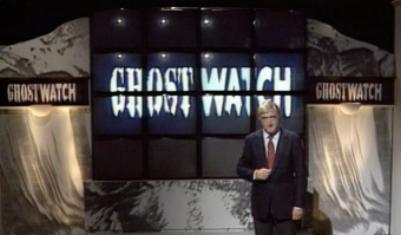

I think I started hanging around the Internet on a regular basis shortly -or perhaps just after - Ghostwatch received it's first (and only) broadcast on the BBC, Halloween night, 1992. Slowly feeling my way across an unfamiliar landscape, I heard rumblings about it, especially some mentions on the Fortean Times e-mail list. However, few people went into detail, so it became one of those things you hear about in whispered conversations on horror movies, or urban legends - something about which you need to know more, because the little you do know is so tantalizing.
Ghostwatch generally came up in conversations in association with two other highly-regarded Beeb productions, The Stone Tape and Children of the Stones. Both of those were written by Nigel Kneale, best known in these parts for his Quatermass serials (or, rather, the movies they became, like Five Million Years to Earth/Quatermass and the Pit). So close was the association that for several years, I thought Kneale had written Ghostwatch. I was quite wrong on that - the writer is Stephen Volk, and though he doesn't know me from Adam and doubtless hasn't found his quality of life diminished in the years I held that misapprehension - sorry, Stephen. Mr. Volk does speak admiringly of Kneale's work, so I don't think he'd be too hurt.
For a while there, I was trading tapes with a gent in England; he needed some obscure American trash, and I needed all of the above shows, along with some Father Ted for Dr. Weasel, who had fallen in love with the show during his honeymoon in Ireland. Oooh, the terrible things the PAL to NTSC transfer did to some (doubtless) second or third generation dubs in those dark days of VHS (they were sadly quite unwatchable, except for the Teds, which looked great) ! Let us all be properly thankful that we live in the 21st century, where a man may possess a region-free DVD player, and have discs flown over the sea in aeroplanes, that he may finally watch TV shows of which he had formerly only heard rumors! Huzzah!
So what exactly is Ghostwatch, and why is it so infamous? My British readers - both of them - already know this, but in America, if we heard about it at all, it was in a brief, har-de-har, News of the Weird type blurb. Ghostwatch is, simply, a ghost story presented as a live TV broadcast. Volk claims that it was never their intention to hoax or defraud the public, and that the best he hoped for was that people would be fooled for - at most - five minutes before they "got it", and then would go on to enjoy the rest of the show.
The problem, of course, is that he was only half right - the other half of the viewers believed it totally, and they panicked.
 Aiding in that phenomenon is the amazing verisimilitude of the production. The show, Ghostwatch, is based on a popular series of the time, Crimewatch. Our major TV presenters, who move the story along, actually are BBC TV presenters, and doubtless the absolute crowning touch is the inclusion of Michael Parkinson, playing himself, as the host of Ghostwatch. Parkinson's career and popularity reaches back to the 50s, and I can imagine Volk and producer Ruth Baumgarten hissing "Yes!" and high-fiving (or whatever it is Brits do under these circumstances) when Parky agreed to do the show. The other presenters were equally familiar - and we'll get to them in a moment.
Aiding in that phenomenon is the amazing verisimilitude of the production. The show, Ghostwatch, is based on a popular series of the time, Crimewatch. Our major TV presenters, who move the story along, actually are BBC TV presenters, and doubtless the absolute crowning touch is the inclusion of Michael Parkinson, playing himself, as the host of Ghostwatch. Parkinson's career and popularity reaches back to the 50s, and I can imagine Volk and producer Ruth Baumgarten hissing "Yes!" and high-fiving (or whatever it is Brits do under these circumstances) when Parky agreed to do the show. The other presenters were equally familiar - and we'll get to them in a moment.
The show will center on a live broadcast from a council home where Pamela Early (Brid Brennan) lives with her two daughters, Suzanne and Kimmy (Michelle and Cherise Wesson, real life sisters) who have reportedly become the center of poltergeist activity. The rooms have been rigged with remote cameras, and a reporter - Sarah Greene, who was largely known for children's programming, like Blue Peter, at the time - will spend the evening there, with a cameraman and a sound operator, hoping to get some footage of the haunting presence.
Outside, with a remote truck, is another reporter who will be interviewing neighbors and such during the evening. This is the face that will be most familiar to American viewers: Craig Charles, who played the feckless Lister in Red Dwarf and is currently hosting Robot Wars on whatever is left of the TechTV cable channel. He's the obvious comic relief, or as Volk puts it, "we could count on him to play the goat."
Also with Parky in the studio is a psychic researcher, Dr. Pascoe (Gillian Bevan) and a roomful of phones and volunteers to answer them, presided over by Mike Green, Sarah's real-life husband and yes, another familiar face to the BBC viewers. A phone number is flashed on the screen throughout the program, so people can call in with their stories of the supernatural.
 I've been racking my brains to try to find Yank counterparts to these folks, to try to get across to my fellow Americans why this thing had such power. The best I can do is Dan Rather or Tom Brokaw as the host, Geraldo Rivera working the phones, Katie Couric - or maybe, to work the children's programming angle, Mary Lou Retton - in the house, and working the crowd outside... I dunno, Regis Philbin. Or if you want the youth market, Carson Daly. I hear he needs the work. And they'd have to be very good at playing themselves under very strange circumstances.
I've been racking my brains to try to find Yank counterparts to these folks, to try to get across to my fellow Americans why this thing had such power. The best I can do is Dan Rather or Tom Brokaw as the host, Geraldo Rivera working the phones, Katie Couric - or maybe, to work the children's programming angle, Mary Lou Retton - in the house, and working the crowd outside... I dunno, Regis Philbin. Or if you want the youth market, Carson Daly. I hear he needs the work. And they'd have to be very good at playing themselves under very strange circumstances.
Okay, so why the panic, besides the fact that this is Halloween and we're almost surely going to be witnessing something spooky? Well, I'm going to be engaging in some SPOILERS here, but I feel pretty safe doing so. The chances of this getting a domestic American release are virtually nil, but the disc is available through any reputable import house. So if you intend to experience Ghostwatch on your own... well, you've been warned.
The first part of the show is reasonably cheery, bland stuff (a perfect imitation of real TV shows of this type), as we set up the situation and the dramatis personae. Dr. Pascoe tells the audience the history of the Early case, and it is to Volk's credit that he hired Guy Playfair, an actual researcher into psychic phenomena, to get the details of the haunting right. (An overview of the case they used as a basis can be found at the bottom of this article on the Fortean Times website about the show.) The poltergeist activity started in the usual way, with odd sounds in the night; Mrs. Early explained this away as noisy plumbing, so when the activity began to escalate, they jocularly nicknamed the spirit "Pipes". But as Pipes' visits begin getting more and more violent, Mrs. Early appealed to the Council to let them move to another house. The Council, finding no bylaws against poltergeists, refused, causing her to go the media with her complaint. Though the story was treated as a joke, it caught Pascoe's attention, and the Early's nomination as the perfect subject for this inaugural showing of Ghostwatch.
Pascoe has some some pretty interesting documentary materials from her examinations of the Early girls. Photos of scratches that appeared on Suzanne's face, and a tape recording of the teen apparently possessed by the spirit of Pipes and speaking in an impossibly deep voice (while not Mercedes MacCambridge voicing Pazuzu, it is creepy). There is also a videotape of the girls sleeping in their bedroom, culminating in a episode of things being hurled through the air and the children running out, screaming.
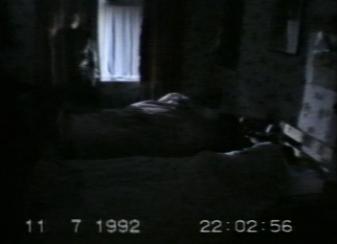 It's after this tape is aired that Mike reports an interesting phone call - a woman asks why no one has commented on the shadowy figure of a woman in the corner during the tape.
It's after this tape is aired that Mike reports an interesting phone call - a woman asks why no one has commented on the shadowy figure of a woman in the corner during the tape.
The tape is replayed, and we now clearly see this figure in the corner, although Pascoe and Parkinson both deny seeing anything. Then it is rewound and played again, and there is no figure there, though Pascoe does use a telestrator to mark out where some curtains might produce the illusion of a woman...
It's the first time, though certainly not the last, that the program will mess with viewers' minds.
As the 90 minute program continues, little bits of our story begin to dribble in, like more phone calls insisting that they have seen the woman - or, as some insist, a man wearing a dress - in the tape. One caller who had grown up in the area tells the local legend of Mother Simmons, a 19th century baby farmer (a sort of paid foster parent) who murdered her charges. This is probably based on this case and adds a sort of eerie resonance to the early part of the show.
During a walkthrough of the home, Mrs. Early shows Sarah a hastily-barricaded door leading to a storage room under the stairs that lead to the house's second story*. Her former husband had set up a darkroom in the space, and she had been using it for a storeroom - and once, while rummaging through the boxes within, the door had slammed shut of its own accord, she found she could not open it, and felt - something - in the room with her. Something that wanted her dead. After finally extricating herself, she nailed the room rather messily shut.
Interspersed with phone calls and stories of encounters with ghosts (actual taped segments of real people - one even has his face pixilated), strange things begin to happen in the house. A perfectly round wet spot appears in the living room carpet, with no visible drips or leaks. Strange noises out back prompts Sarah getting frightened by a spring-loaded cat, shortly after which the famous banging in the pipes is heard - and one of the remote cameras catches Suzanne upstairs, whacking on the plumbing.
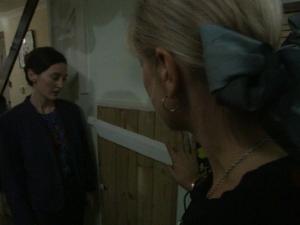 Parkinson is convinced the whole thing is a fraud, and is supported in this by a loutish American scientist on a satellite link. (I love this guy - he's like Gary Cole's English cousin) Pascoe isn't so sure (of course), and after Mike presents a series of phone calls, all giving the same description of the shadowy figure in the videotape, she plays a videotape made weeks earlier, where the youngest daughter - the only one who claims to have actually seen Pipes - describes the ghost.
Parkinson is convinced the whole thing is a fraud, and is supported in this by a loutish American scientist on a satellite link. (I love this guy - he's like Gary Cole's English cousin) Pascoe isn't so sure (of course), and after Mike presents a series of phone calls, all giving the same description of the shadowy figure in the videotape, she plays a videotape made weeks earlier, where the youngest daughter - the only one who claims to have actually seen Pipes - describes the ghost.
The description is the same.
Predictably, at this point, all hell starts breaking loose. The crew inside the house keeps hearing a yowling cat, seemingly trapped somewhere within the walls. The teenager is apparently attacked by Pipes, the scratches again appearing all over her body. She lies on her bed, feverish, dazed, hypertense, any touch painful to her.
The phone calls coming into the station are building in pitch, too. Reports of poltergeist activity happening during the show, including one woman whose glass-topped dinner table has simply exploded, sending her husband to the hospital. "His blood is all over the walls... my children won't turn off the TV... why are you doing this??!!!"
One caller confirms that the Mother Simmons story is real, and the woman lived in that area - perhaps even where the Earlys now live. An attempt to get the girls out of the house - accompanied by a sudden banging on the walls - is aborted when the teenager jams herself in a corner and starts speaking in that impossibly low voice, "What big ears you have, what big eyes you have..." The electronics are beginning to mess up. Pictures fly from the walls. The yowling is getting worse, and it seems to be coming from that storeroom under the stairs...
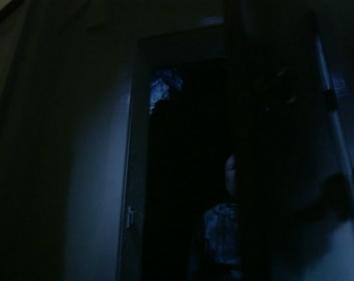 The crew tears down the makeshift barricade and slowly open the door... there's someone in the room...
The crew tears down the makeshift barricade and slowly open the door... there's someone in the room...
And then a flying mirror takes out the sound man. The teenager starts shrieking that Pipes has her. The remote cameras switch from room to room, searching for her, to no avail. She screams...
And the screen goes black. A hasty sign is put up until a signal outside the house is established, catching Craig by surprise, unaware of what is going on inside the house. After Craig improvises madly, the signal is re-established inside the house, showing everyone happily playing a board game in the living room. They're still unable to contact anyone inside the house, but the peacefulness of the scene has everyone relieved, and not a little mystified.
Another caller, refusing to identify himself except as "a social worker", provides the last piece of the puzzle: in the 60s, the occupants of record of the Early's house sub-let a room - illegally - to their nephew, who had just been released from a psychiatric hospital, where he had been confined for child abduction and molestation. The worker feels the man was seriously disturbed, because he claimed he was being possessed by the spirit of a woman, and had, in fact, started wearing dresses. One day, while his aunt and uncle were away on holiday, he killed himself by walking into the storeroom, where his tools were kept, tying one end of a length of wire around his throat, the other end around a lathe, and turning on the lathe. He wasn't found for twelve days. During that time, his dozen or more cats, locked into the house with him, got hungry... and went to work on his face.
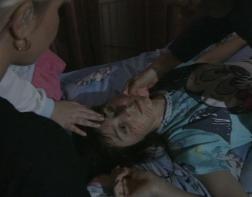 Pascoe finally realizes that what they're seeing from the house is impossible - a picture on the wall that was flung off has miraculously reaffixed itself. They are looking at footage from earlier in the evening. "It's in the machine!" (Yes, Volks somewhat ashamedly admits he was unable to resist that reference)
Pascoe finally realizes that what they're seeing from the house is impossible - a picture on the wall that was flung off has miraculously reaffixed itself. They are looking at footage from earlier in the evening. "It's in the machine!" (Yes, Volks somewhat ashamedly admits he was unable to resist that reference)
As if on cue, a montage of scenes from the evening play out on the screens, as an impossible wind whips up in the studio. Pascoe tells Parkinson that they have unwittingly conducted a seance on a national level - and have invited something old and very, very bad into their studio... and into every living room in Britain that was watching the show, increasing its power exponentially.
Live footage is back from outside the house, as the bleeding, still unconscious sound man is taken away in a guerney. Mrs. Early and the younger girl, Kimmy, have made it out, too, but in the house, Sarah and the camera man are still looking for Suzanne - in a house now without lights, of course. She is heard calling from the store room. Sarah opens it, and despite the pleas of the camera man, reaches in to try and find her. She is jerked into the store room, the door slams shut...
In the studio, chaos reigns. Lights are exploding, the winds are getting worse, floor supervisors are yelling for people to evacuate... and the screen goes black.
After a moment, one camera comes on, revealing a disoriented Parkinson wandering the set. He finds the one working camera, and notes that the teleprompter is operating, but only nonsense is showing. He reads it: "What big ears you have... what big eyes you have... fee fi fo fum, fee fi fo fum..." and as his reads, his voice deepens to the gutteral tones of Pipes. Cut to black as cats yowl.
 Now, the interesting thing about Ghostwatch - I wasn't particularly frightened while watching it, but I frequently get the creeps while remembering it. It undeniably got under my skin, and I set out to understand why. Besides it being a well-told ghost story, I mean.
Now, the interesting thing about Ghostwatch - I wasn't particularly frightened while watching it, but I frequently get the creeps while remembering it. It undeniably got under my skin, and I set out to understand why. Besides it being a well-told ghost story, I mean.
The aftermath of the broadcast is well documented (once again, I reference the article at Fortean Times, the Museum of Hoaxes, and this portion of the BBC site), and despite its infamy, it has never been re-broadcast, and only appeared on DVD recently (thank you, British Film Institute!). But one intriguing thing I found in my research, was when Volks talked about the schoolyard arguments about how many times Pipes appeared in the show, "and we only showed him about eight times".
That stopped me. I had noted Pipes only four times during my first viewing, all pretty overt: that initial videotape, the opening of the storeroom, in a burst of static, and one brilliant moment when the cameraman turns around in the girls' bedroom, passing Pipes in a quick swish-pan... then when the camera snaps back, he is gone. Great moment.
Ah, but this is the DVD age, so armed with a Google search of newsgroups and forums, I began hunting down Mr. Pipes, and finding out why some scenes filled me with apprehension. The false scare with the cat at the back sliding glass door seemed significant to me somehow, at the time. Freeze-frame that sucker, and there's Pipes, reflected in the glass door. When Pascoe plays the creepy audio tape of the possessed teen speaking with Pipes' voice, there is a shadowy figure behind her, which I had thought to be a technician or one of the phone crew; nope, it was Pipes himself.
One I would have never found without a forum post: Craig is doing one of 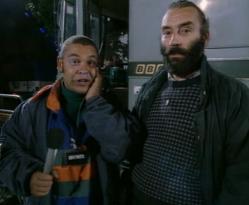 his neighborhood interviews in a nearby playground, where two local women tell him about the morning a dog was found torn apart there. "She was pregnant, too... there were fetuses everywhere." Craig finds his usual light banter useless against such horror, and leaves the playground to pick up his next interviewee, who is standing in the crowd - a man who once tried to exorcise the house. But also in the crowd - and only there for about three frames, standing behind two women, smiling - is Pipes.
his neighborhood interviews in a nearby playground, where two local women tell him about the morning a dog was found torn apart there. "She was pregnant, too... there were fetuses everywhere." Craig finds his usual light banter useless against such horror, and leaves the playground to pick up his next interviewee, who is standing in the crowd - a man who once tried to exorcise the house. But also in the crowd - and only there for about three frames, standing behind two women, smiling - is Pipes.
The eighth appearance, if it exists, still eludes me. But it's careful planning like that which ultimately raises my opinion of Ghostwatch, which was already pretty high.
This was far from the first program to use these tools to tell a story - of course, Orson Welles and the Mercury Theater of the Air's radio version of War of the Worlds remains the first card pulled out of that particular deck, but there are two American telefilms that should stand in this company, Special Bulletin and Without Warning. Special Bulletin concerns the kidnapping of a TV news crew by a group of homegrown terrorists who are threatening to set off an atomic bomb in Charleston, and it really deserves a DVD release. Without Warning holds a special place in my heart, as I thought I was going to see a disaster movie about a meteor hitting America - only as the story unfolded, it's not a meteor, it's the first in a series of alien vessels falling at various points across the globe!
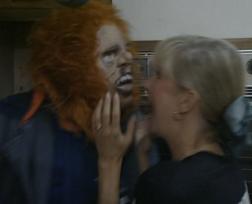 Neither of those had the possibility for panic built-in to Ghostwatch, however - Without Warning's story could not take place in the space of two hours, so the passage of time was quite obvious, and both had disclaimers running before the return from commercials. Special Bulletin also had the recognizable actor Ed Nelson as an anchorman.
Neither of those had the possibility for panic built-in to Ghostwatch, however - Without Warning's story could not take place in the space of two hours, so the passage of time was quite obvious, and both had disclaimers running before the return from commercials. Special Bulletin also had the recognizable actor Ed Nelson as an anchorman.
Ghostwatch had story credits before the show - very quickly, as they were a last-minute addition, insisted upon by the BBC. That phone number was also quite real, with an actual phone bank manned by members of a psychic research society, who opened every conversation with the information that the show was drama, not real, and not to be taken seriously. Apparently, they couldn't answer enough calls to forestall the panic.
Movies like Blair Witch Project and Cannibal Holocaust belong in this category, too, but these lack the primal immediacy of television, which is, to so many people, a prima facie member of the family. Therefore, they don't have the ability to betray you as does something masquerading as a news-type program.
So did Volks actually attempt to defraud the public, despite his denials?
I say no, and the evidence is in the show itself. Go through the forums as I did, and most people will site the sudden wind whipping up in the studio as the moment that the show went over the top, that they were jarred out of the "reality" mindset and into the "ghost story" mindset. The wind isn't a decision that you make if you're trying to fool people - it is a decision you make for a ghost story.
If nothing else, I can no longer hear the word "Pipes" without feeling a bit of a shudder somewhere in my psyche, and remembering Ghostwatch. And that lingering ability to intrude into the daylight world is undeniably the mark of an excellent horror story*.
